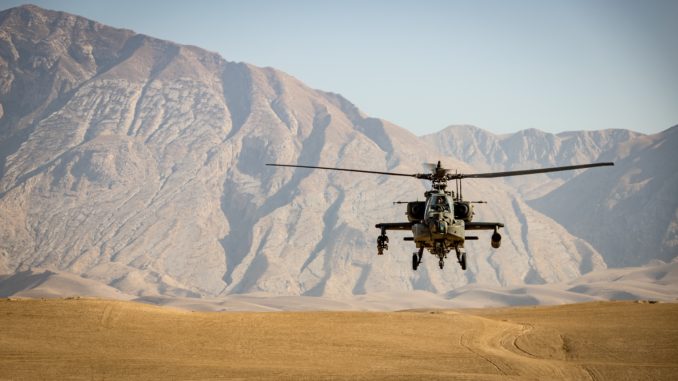
A dizzying amount of commentary, both solicited and not, has been spared on the Taliban’s brutal, unilateral recovery of power in Afghanistan. Unlike a great majority of political events, it is far from unwarranted. Any sane person observing such a horrific spectacle, certainly amplified by sharp memories of the Taliban’s appalling human rights record prior to the U.S. incursion, would feel compelled to offer an observation or two, despite how redundant it may be.
Coincidentally, exactly 23 years ago, as part of a wider effort to “counter an immediate threat from the Bin Laden network,” known officially as Operation Infinite Reach, the Clinton administration struck “terrorist facilities and infrastructure” in Afghanistan, where it believed “a gathering of key terrorist leaders” was to take place. The attack failed according to then counter-terrorism czar, Richard A. Clarke, who later lamented that the public backlash made it more difficult to continue counter-terrorism operations in the region. [1] The Taliban, on the other hand, in the months following Infinite Reach, while officially condemning the attack and stating that the endeavor’s main target, Osama Bin Laden, would never be handed over to the United States, resolved to secretly negotiate with President Clinton and his staff over the extradition of the al-Qaeda leader. Notwithstanding their rhetoric, the group was not too fond of him; in fact, Mullah Omar, the leader of the Taliban, once stated that Bin Laden “is like a chicken bone stuck in my throat; I can neither swallow him nor spit him out.” [2] For their part, the United States “was willing to pay almost any price for Bin Laden” as well as grant diplomatic recognition to the government (which the Talib regime craved) and “millions of dollars in cash plus millions in humanitarian aid,” eclipsing the so-called prevailing issue of “women’s rights,” which U.S. negotiators intimated they could be flexible on. [3] The dynamic, as universally acknowledged, changed drastically after the attacks of September 11. There was no longer any compromise to be had; the Taliban were either to hand over Osama Bin Laden or they would be taken out. The United States simply would not tolerate this massive affront to its “national security”.
What followed needs no recounting, though it did receive its fair share of critics at the time, quite markedly, from opposition groups within Afghanistan. In an interview with the Carnegie Endowment for International Peace, former mujahideen fighter and major Taliban adversary (as well as later victim) Abdul Haq argued that the United States “is trying to show its muscle, score a victory, and scare everyone in the world”; his view was shared by the Revolutionary Association of the Women of Afghanistan, otherwise known as RAWA, who, in a rallying cry to the Afghan people, condemned United States for “launching a vast aggression on our country” after supporting harmful policies in the region for years. Haq and RAWA also came to a chilling conclusion in deriding the Western military blitz: namely, that the invading powers did not care what would happen to ordinary Afghans. The observation seemed fair enough; after the U.S. assault had begun, the Taliban all but backed off, or, in the words of one Afghan, had “vanished like ghosts”. [4]
However, as the highly respected Pakistani foreign policy commentator and journalist Ahmed Rashid chronicles in his excellent series on the war, the United States’ gross incompetence bordering on indifference, lack of strategic (and sufficient) financial investment as well as adequate military support beyond indiscriminate bombing, and overall willful ignorance of the complexities in Afghan society, doomed the venture before it could have any meaningful impact, thus inadvertently restoring the Taliban’s political viability. Narrating how the conflict was treated as a “sideshow” by the Bush administration in favor of the war in Iraq, made abundantly clear by the West’s “dependence on warlords” for Afghanistan’s security, and the way President Obama, while making superficial plays to portray some level of commitment to “fighting terrorism” (such as increasing troop presence), ultimately showed little interest in improvements to policy, Rashid paints a picture of extreme dysfunction spawned by a startling lack of seriousness in regards to the 20-year war effort. [5] This not only guaranteed anti-U.S. sentiment amongst Afghans, but, with some help from neighboring Pakistan, allowed the Taliban to take advantage of the weaknesses in the Western-backed government. [6] Rashid’s grim assessment was shared by the Special Inspector General for Afghanistan Reconstruction’s office (SIGAR), who, in its final report, also noted a fundamental defect of the entire “nation-building” process: The metric of the project’s success, for no other reason than it was easier for Congress to monitor, was based on “money spent” rather than “program effectiveness.”
Predictably, while allowing political leaders and top military brass to spout the rhetoric of “progress,” this framework left little room for robust monitoring-and-evaluation (M&E) mechanisms, thereby blocking “honest assessments” of reconstruction work. All of this at the expense of $2 trillion in U.S. taxpayer cash (a sizable chunk of it consumed by corruption) and the hopes of “30 million Afghans and the U.S. soldiers fighting for them.” [7] Yet, curiously, the standard judgment across the board characterizes the Afghanistan adventure as a “mistake,” “massive failure” and “defeat” for the United States, as opposed to what indeed sounded like a way for United States “to show its muscle,” without considering the consequences, and then consciously neglecting the fallout.
Of course, the questions that immediately arise are why so many years and why so much money. Some say for profits of the defense industry/private contractors (Eisenhower’s famous “military-industrial complex”), others cry imperialism/hegemony, or perhaps it truly was a noble cause that went awry. Probably the most cynical of these theories, and thereby, the most popular, is the first. Yet the profits that the defense industry or, for example, the Department of Defense (DoD)’s top five military contractors, Lockheed Martin (LM), Boeing, Northrop Grumman (NG), General Dynamics Co (GDC), and Raytheon made off of Afghanistan, look fairly unremarkable when their revenues are explored more carefully.
It is certainly true that all five of these companies not only reported a significant uptick in their stock value but also their profits during the Global War on Terror. However, the United States’ intervention in Afghanistan played little, if any, direct role in their fortunes. According to an analysis done by Avascent (a management consulting firm well-known for advising the defense industry), while defense stocks “provided annualized returns of 14 percent versus a broader market that was up only one percent” from the time the War on Terror was declared in 2001 to the 2008 election campaign (which oversaw substantial increases in spending by the DoD), they fell below the broader market after “rising concern over the federal budget deficit” led to a disruption in investor confidence over “growth prospects for defense.” To compensate for this, the industry focused on different strategies such as “divesting less profitable businesses” and stock buybacks, as opposed to relying on Pentagon spending, eventually returning the industry to a 12 percent profit margin by 2014; then, when the Trump Administration arrived in 2015, significantly increasing the defense budget to serve “a National Defense Strategy that focused squarely on China” (which did not come close to post 9/11 spending), the defense industry reverted to its original blueprint. Beyond this, Afghanistan’s meager role is illustrated even more vividly when one probes how exactly the $2 trillion was spent. Although the DoD has never been particularly clear on this point (for reasons one could guess), it has repeatedly been pointed out that perhaps the most bizarre feature of the Pentagon budget is how much of it is unrelated to actual military engagements. Indeed, there is a massive figure presented every year for both congressional approval and the public eye, but these funds are reserved for the Pentagon’s more bureaucratic functions such as paying salaries, endowments for research and development, weapons procurement, etc., otherwise known as the “base budget”. It is also where the money for contracts with “defense hardware” firms such as LM, Boeing, GDC, NG and Raytheon comes from. Funds reserved exclusively to “theaters of war” such as Iraq and Afghanistan are part of what is called the Overseas Contingency Operations (OCO) budget, and though the money provided, usually upwards of $100 billion annually, pales in comparison to the base budget, it is surely nothing to take lightly. In fact, the main targets for criticism in (rightly) highlighting the role of the private sector in Afghanistan, that is, private mercenary companies such as Dyncorp Intl., (now Amentum) and construction companies, such as Fluor Global, receive their funds from the OCO budget ($107 billion since 2002). It should be understood, however, that these companies are international in scale and reach. There is no doubt that Afghanistan presented a number of payday opportunities and, according to most sources, will continue to do so; this does not make U.S. involvement there a necessity. More than anything, to say that the United States launched a ground invasion of an already unstable country, and wasted a few trillion dollars so private contractors could make a few billion, sounds like lazy analysis at best, and regurgitating ideological doctrine at worst. This is not to say that ideological doctrine is inaccurate, lest we forget the age-old adage of the broken clock. Those decently familiar with the history of U.S. foreign policy in the past 100 years are well aware that the United States has deliberately intervened in other countries to install governments favorable to its interests (such as controlling resources) and given support to authoritarian regimes for the same reason; in truth, one would be hard pressed to find examples (barring the Second World War) of U.S. intervention where neither of these are the case. As such, arriving at such conclusions about the War On Terror is completely fair, but in the case of Afghanistan, it is wrongheaded.
Firstly, while there has been significant hype over the “trillions” of dollars in mineral reserves the Taliban now has control over, there is also a significant amount of uncertainty regarding their extraction potential, especially since “large foreign investments” (including a few by China) over the years have “largely failed”. This is not to say it is an impossibility. Perhaps the Taliban’s authoritarian streak will provide the level of order required to make them a major player in rare-earth and natural gas markets, but before that happens, they will require international legitimacy. This is where power matters, and in the current international order, where U.S. power is decisive.
When the U.S. withdrawal commenced, many declared the end of “liberal imperialism”, that Afghanistan was truly “the graveyard of empires”, and U.S. power/credibility had finally reached its limits. Interestingly, these statements go little beyond ideological cliches, peripheral knowledge of Afghanistan as well as its history, and Western-variety sentimentality, which, ironically, attempt to condemn the same type of statements that many say lit the spark for and sustained the invasion. One should recall, though, the relationship between the United States and the Taliban prior to the 9/11 attacks, and examine what exactly has changed. As laid out above, the Taliban had no principled commitment to sheltering Bin Laden and his fellow Al-Qaeda operatives; a fledgling “Islamic Emirate” at the time, diplomatic recognition from the United States would, de facto, grant them international legitimacy as a state and most likely, a spot in the international economy. 20 years later, Osama Bin Laden has been assassinated by U.S. Navy Seals (shockingly, he was not in Afghanistan), the “nation-building” project in Afghanistan is supposedly a “failure”, and the Taliban has revived its Islamic Emirate. Have their goals changed in any significant way? According to the treaty (known as the Agreement for Bringing Peace to Afghanistan) negotiated between the Trump Administration and Taliban representatives in Qatar last February (notably, without the presence of the Ghani government), not at all. In exchange for pulling out U.S. troops, a pledge not to intervene in internal Afghan politics, and (reviewing) the easing of sanctions, the Taliban has agreed to adopt U.S. security interests and abide by them to a tee. Rather strange terms for a group that “defeated” the United States; one would think they might demand a bit more than an “official withdrawal” (while saying nothing about U.S. private contractors), and a promise not to intervene in a politics that U.S. officials, by their own admission, were already quite ignorant of. Most importantly, the lifting of sanctions, crucial for the Taliban if they hope to avoid famines and take the first step towards official diplomatic recognition, looks as though it will happen slowly at the whim of U.S. President Joe Biden, rightly or wrongly. Indeed, the future of Afghanistan looks like it will be made on the United States’ terms.
As the population of Afghanistan becomes ensnared in the mayhem of U.S. evacuations, harsh offensives by a looming Islamic State, and the Taliban’s violent struggle to solidify their control, it is imperative that we ask ourselves whether or not the U.S. withdrawal, much like the invasion itself, was a wise decision. Whatever the present theatrics of international news outlets may suggest, there is no doubt that the 20 years of callousness displayed towards Afghanistan by four U.S. presidential administrations as well as the U.S. media indicates that a quick exit from the country was not only inevitable but desirable. Incredibly, the reaction of ordinary Afghans, especially Afghan women, again, much like the invasion itself, seems to demonstrate otherwise. Though, at the end of the day, they should realize that U.S. power is as forceful as it ever was. If it was not so, perhaps their objections would have been heard and possibly heeded.
Bharat Tangellamudi is a freelance writer.
Footnotes
- Richard A. Clarke. Against All Enemies: Inside United States’s War on Terror. (New York: Free Press, 2004)
- Alex Strick van Linschoten and Felix Kuehn. An Enemy We Created: The Myth of the Taliban-Al Qaeda Merger in Afghanistan. (New York: Oxford University Press, 2012). 164-179.
- Jonathan Cristol. The United States and the Taliban Before and After 9/11. (London: Palgrave MacMillan, 2019), 51-60.
- Anand Gopal. No Good Men Among the Living: United States, the Taliban, and the War Through Afghan Eyes. (New York: Henry Holt and Co., 2014), 8.
- Ahmed Rashid. Descent Into Chaos: The United States and the Failure of Nation Building in Pakistan, Afghanistan, and Central Asia. (New York: Viking Press, 2008), 196-200; Ahmed Rashid. Pakistan on the Brink: The Future of United States, Pakistan, and Afghanistan. (New York: Viking Press, 2012).
- Ahmed Rashid. Taliban: The Power of Militant Islam in Afghanistan and Beyond. (London: I.B. Tauris, 2010).
- Rashid. Pakistan on the Brink. 94





